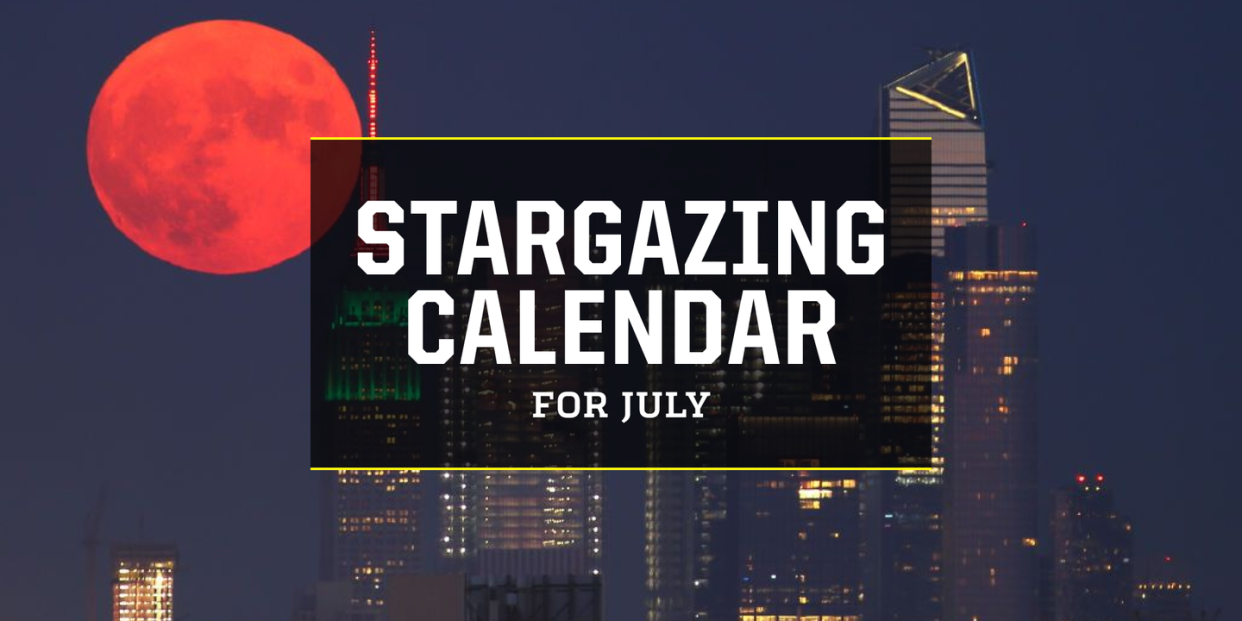Your Stargazing Calendar for July 2022

The July Buck Moon will offer the biggest and brightest supermoon of the year.
Set up your telescope to view the massive Comet K2 on July 14.
Get an early start on the ever-popular Perseids meteor shower, the largest of the year.
A trio of meteor showers, the boldest supermoon of the 2022 calendar, and a relatively new—and huge—comet highlight the July night sky. As the Buck Moon prepares for a July 13 appearance, Comet K2 approaches Earth a day later. And three different meteor showers will stretch through July, each bringing with it a different level of intrigue.
💫 Meteor Showers: Starting July 7
The mix of the Alpha Capricornids, the Delta Aquarids, and the start of the famed Perseids will shower July with a heavy dose of meteors, especially near the tail end of the month.
The Alpha Capricornids shower kicks off annually on July 7, running through August 15; the peak occurs on July 30. Aptly named for its activity within the Capricornus constellation boundaries, the Alpha Capricornids is not the most spectacular offering of the month, according to the American Meteor Society. Considered an infrequent source of meteors from comet 169P/Neat—typically only about five per hour at peak overnight times, a low number for a meteor shower—the shower nevertheless can present some spectacular views of slow-moving fireballs.
A new moon will darken the skies at the right time to catch up to 20 meteors per hour during the Delta Aquarids meteor shower. Running from July 12 through August 23, Delta Aquarids will peak on July 28 overnight, into the morning of July 29—an exact match with the new moon schedule. Originating from the Aquarius constellation (although the meteors really can show at any point in the sky) from the comet 96P/Machholz, those in the southern United States will have the best opportunity to see the meteors. And the pre-dawn hours are considered the best times, but any time after midnight should still satisfy meteor watchers.
The Perseids offer the primetime meteor shower event of the summer, especially for those in the northern United States. And while the peak of this show isn’t until August 12, it does run from July 17 to August 24, giving those anxious for an early start time in late July an opportunity to see three meteor showers happening all at once. The August timeframe unfortunately matches up with a nearly full moon this year. However, with as many as 100 meteors per hour from comet 109P/Swift-Tuttle at peak time, even a non-peak July occurrence can offer quality viewing. The Perseids appear to originate from the Perseus constellation and are known for their large fireballs, leaving long wakes of light and color for longer visibility than other meteor showers.
➡️ Check out our full 2022 stargazing calendar
The added benefit of a New Moon on July 28 (when the moon is on the same side of Earth as the sun and not highly visible) coinciding with peak meteor times in late July could lend additional splendor to your stargazing.
🌕 Full Moon: July 13
The July full moon occurs just nine hours after the Moon travels to its closest point to Earth, known as perigee. That means the July 13 supermoon (the second of three in 2022) becomes even more impressive. Dubbed a “Buck Moon”—the name comes from Native American history noting when buck deer begin to grow new antlers—the supermoon should appear about 7 percent brighter and bigger than a typical full moon because of its location. June’s Strawberry Moon, also a supermoon, was a mere 150 miles farther away than the July Buck Moon, so we’ll have an even more spectacular show in July.
We see a full moon when the moon’s entire face is illuminated by its position on the opposite side of Earth from the sun. Typically, we get 12 full moons each year, and they each have their own name based on the month.
The Buck Moon’s peak is at 2:38 p.m. ET, so watching the moonrise should offer plenty of brilliance on July 13, as you take in the biggest and brightest supermoon of 2022.
☄️ Comet: July 14
The Comet C/2017 K2 will draw nearest to Earth on July 14, near enough to spot it via small telescopes in the two months before, during, and after July. Discovered relatively recently in 2017, the comet holds plenty of intrigue for stargazers.
When astronomers first discovered Comet K2, it was at its farthest point from Earth, 1.49 billion miles away—16 times the distance between Earth and the sun. After July 14, we’ll have to wait a million years to see it up close again. Astronomers haven’t pinpointed the exact size of Comet K2, which could be anywhere from 18 to 100 miles wide, but it could register as one of the largest on record, and includes a massive tail stretching 500,000 miles. This rock and ice formation, with a mix of nitrogen, carbon dioxide, carbon monoxide, and molecular oxygen, could change as it nears the sun. So what was dubbed a “primitive” comet in 2017 may do some growing up before our eyes this July.
You Might Also Like

